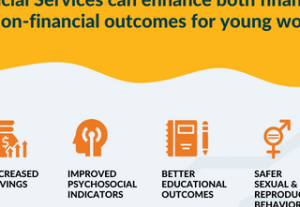More low-income individuals are generating digital footprints through their phones than ever before. CGAP’s recently published Global Landscaping Study on the Data Trails of Digitally Included Poor (DIP) People estimates that in 2021, 1.8 billion low-income people (earning under USD 5.50 per day) in low-and middle-income markets had digital access (as defined by ownership of or access to a phone). This number is slated to grow to about 2 billion people by 2025. Despite progress in digital access among low-income individuals, gender-based differences remain, with women lagging behind men in both digital access and generation of data trails.
The increased digitization of the economy opens opportunities for financial services providers (FSPs) to experiment with models that leverage data trails to serve low-income individuals. As data-driven models within financial services become more prevalent, women who already lag behind men in financial access and usage could be further disadvantaged if FSPs do not account for gender-based differences in the generation of data trails.
This blog examines five gender-based findings on the data trails being generated by low-income individuals and proposes potential action for FSPs and financial sector authorities to address these gaps.
1. Women lag behind men in phone ownership and the associated digital footprints that are generated by phones
The Digitally Included Poor (DIP) – defined as adults (above age 15) in low- and middle-income countries, earning less than USD 5.50 per day with ownership or access to a phone – are a growing segment. However, we estimate gender gaps among the DIP segment – 63% of women (compared to 79% of men) in low- and middle-income countries own a phone resulting in an absolute gender gap of roughly 192 million in phone ownership (See Figure 1). Efforts to digitize and make data available (with consent) in contexts where women are well represented (like savings groups or G2P transfer recipients) could help address the gap in representation.
2. Women tend to lack access to sophisticated devices like smartphones and are more likely to be dependent on shared devices which further limits their digital footprints
According to GSMA’s Gender Gap Report, women in low- and middle-income markets are 18 percentage points less likely to own a smartphone and 16 percentage points less likely to use mobile internet than men. In India, low-income women are less than half as likely to own a smartphone compared to low-income men. Even among those who own a smartphone, women are more likely to have a lower-quality device. The data trails from basic phones are not as rich as the data trails from smartphones which limits the digital footprints of women.
Additionally, a larger percentage of women rely on shared or borrowed phones than men. Our estimates suggest that about 200 million low-income individuals, a majority of whom are women, use shared phones in low- and middle-income markets. Digital footprints from shared phones are not attributable to the borrower of the phone and cannot be used as a clear indicator of women’s behavior since the phones are more likely to be under their male relative’s name.
3. Women lag behind men in their use of digital services in low- and middle-income markets
We conducted surveys to understand the digital footprint of DIP people in five markets (India, Indonesia, Kenya, Mexico, and Senegal). In Kenya, women lag behind men in the use of phones for accessing services like information, entertainment and social media. Gender parity in the use of phones is limited to making or receiving mobile money payments and making or receiving payments on e-commerce platforms. Similarly, in Senegal, women lag behind men in smartphone ownership, internet access and use of services like social media, entertainment and information. Communication is the only digital service for which more women than men use their phones in Senegal.
4. Among smartphone users, men spend more time connected to higher-quality networks (meaning they access higher mobile internet speeds) than women
As part of CGAP’s Global Landscaping Study, we undertook research on the data trails generated through smartphones in five markets across Sub-Saharan Africa (Côte d’Ivoire, Ghana, Kenya, Nigeria, and South Africa). On average, men spend a higher proportion of time on higher-quality networks than women (as is evident in Figure 2) which potentially results in richer data trails for men. Women spending less time on higher-quality networks could also be an indicator that women have lower-quality handsets than men. FSPs designing digital financial products should account for the lower quality of devices used by women both to analyze the behavioral characteristics of women while designing and pricing products as well for user interface and experience design.
5. While gender differences exist, in cases where there is gender parity in digital access, there are some important similarities in the data trails being generated by men and women
Across the five markets covered in our smartphone users’ study, over 90% of women and men generated data on airtime top-ups. While women are less likely to own a smartphone, those that do have a very similar median value of airtime top-ups than men who use smartphones, as indicated by Figure 3.
It is evident that while both low-income women and men are increasingly generating more and higher quality data trails, there are gender-based differences in the volume and richness of these data trails. Here are some actions that different actors could take so that women are not placed at a disadvantage due to gender-based differences:
- FSPs: The increased volumes of data trails being generated by low-income women should be leveraged as an opportunity for FSPs to design gender-smart products and services.
- Financial sector authorities: It should be incumbent on financial sector authorities to design and implement frameworks and incentives that encourage FSPs to collect and use gender-disaggregated data with the goal of closing financial inclusion gaps. Additionally, the robust implementation of consent-based data-sharing initiatives like Open Finance, which are typically regulated by central banks, could help expand access to transactional data (like G2P payments or retail purchases) where women are better represented.



